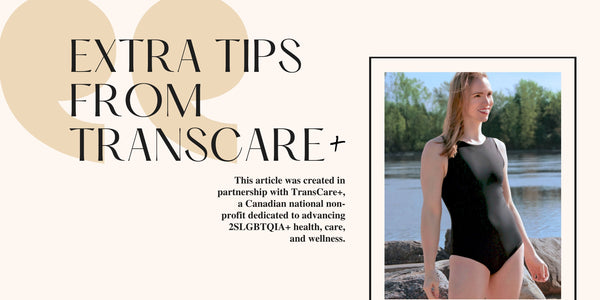How to Tuck While Swimming
Have you read the Tucking 101? You may want to start there!

This article was created in partnership with the Canadian National Non-profit Organization TransCare+! Read more about them at the end of this blog.
Swim season is upon us! It’s that wonderful (or sometimes terrifying) time when we wear less clothing and put our bodies in the sun and water as much as possible. Here at Origami Customs, we want you to feel comfortable in the summer, which is why we make so many swimwear options to help you feel good in your body.
We’re adamant in our belief that you have a right to be at the beach or pool, (check out the blog Your Queer Body is a Beach Body) and we want you to feel comfortable in doing so! So this year, we’re going to give a 101 on Tucking While Swimming, with the help of our amazing healthcare friends over at Trans Care+.

What is Tucking?
Tucking is a practice embraced by some trans folks who want to present a smoother silhouette in various outfits, including swimwear. While compression garments like tape and gaffs can provide compression that smooths out your front, tucking actively shifts your genitalia from the front of your body to enhance that smoothness even more.
Tucking while swimming (and tucking in general) is a deeply personal choice. Hopefully, you’re in a situation where you can choose to tuck as a matter of affirmation, rather than out of concern for your safety. We think that all bodies are beautiful, (read this awesome article!) and we don’t want you to have to tuck out of fear or shame. We also don’t want to imply that “passing” should be the point.
We want you to feel good in your body, and however you want to rock your silhouette, we support you! And if tucking feels affirming and good for you, then we want you to rock it! We also want you to be able to do it safely and comfortably, so here are a few tips!
Tips from TransCare+ on Tucking

Choosing Your Tucking Item
There are a variety of methods for creating a secure, comfortable tuck. Tucking involves moving your genitalia from your front to between your legs and then using a gaff, compressive swimwear, or an adhesive like tucking tape to hold it in place.
Firstly, you’ll need to choose what type of item you’ll need to maintain your tuck. People have different levels of comfort and enjoyment out of the different options so feel free to experiment to find what works best for you.
Gaffs
Gaffs are reusable and provide a very strong hold. However, when wearing under swimwear you’ll want a swim-safe material (all ours are swim-safe!) and they may produce visible lines where the gaff waistband exists. We have a guide here to choosing the right gaff, and you can always reach out to us for more advice on which gaff will go best under which swimsuit!
Adhesives
Adhesives can often provide the flattest and seamless tuck, but need to be purchased for individual use and may require some skin prep. Depending on the adhesive, it also may loosen during swimming.
Compressive Swimwear
Compressive swimwear may not always hold the same as an adhesive or gaff depending on your specific body and needs, but are relatively easy to adjust (and you’ll be wearing a swimsuit anyway!)
All Origami Customs’ swimwear comes with a moderately compressive liner (one layer of our swimsafe gaff mesh), for compression without or without a tuck. All our gaffs are also swimsafe, so you can layer them underneath the swimwear for extra strong hold!
Swim bottoms are great on their own if you don’t want to tuck all the time, but might want the option. They also minimize/flatten without the need for a full tuck, which can feel great for some folks.

Step-by-step Instructions on how to Tuck
Tucking Step 1- Move your Genitalia
The process of tucking, regardless of method, involves moving the testes inside the body (into what are called the inguinal canals) and pulling the penis down (typically over the scrotum) between the legs.
The inguinal canals are present for everybody who develops testes; they are where the testes originally ‘dropped’ from. They are present inside the scrotum - only the testes will move up into the canal while the scrotum stays external.
Tucking Step 2- Put On a Compression Item
If you are using a gaff or compressive swimwear, you slide the underwear over the penis once the testes are securely inside your body and use the gaff/swimwear to hold everything in place.
If you are using an adhesive, instead the adhesive would be used to hold the penis/tuck in place. For various adhesive methods, some skin prep may include shaving, exfoliating, and removing any natural skin oils or lotion.
If you are using an adhesive, Pack a second tucking kit with you. Many pools and bathrooms have access to private change rooms and/or bathrooms where you can start the process again. If you’re at an outdoor beach, it's possible a car could be made comfortable enough to adjust your tuck as well.
Tucking Step 3- Testing your Tuck
Check yourself out! Take a look in a mirror if you have the space. Try moving around, particularly focusing on moving your legs and hips. How does it feel and look for you? It shouldn’t be uncomfortable, and if you feel skin catching or chafing against something that is a sign that you need to readjust. Ultimately, whatever orientation feels comfortable for your body and provides the look you are aiming for is a success!
Tucking Step 4- The Rise And Fall Of The Tuck
Like anything we put on our bodies such as makeup, sunscreen, or deodorant, things tend to wear off during the day. The same can be true of any tuck. As you go in and out of a pool or sweat on the beach the adhesive on the tape can start to lose its grip and the desired tuck may start to fall out of place.
Time your day with your tuck. With some practice and time, you might start to know your products and body better and know how long your tuck lasts. Different products can provide a differing level and length of comfort so that you can plan your day with your tuck.

Extra Tucking Tips from the TransCare+ Team
- Try out tucking in a safe place before trying it out in public! Gaining comfort with the outfits and technique by yourself can improve your confidence while out in public.
- Listen to your body! If something is causing any pain or irritation, look for a place where you can feel safe to make an adjustment. Chafing or irritation will make it more difficult and uncomfortable to tuck on future days until that subsides.
- Occasionally, your tuck will fall out. Be prepared for this, both practically and emotionally. From experience, you are going to be immediately sensing that your tuck has fallen out but it's unlikely others will have any idea. Due to this, the sensation of the testes moving out of the inguinal canal when you aren’t expecting may be an uncomfortable shock of social anxiety.
- The tuck you desire for your own comfort and joy often differs on the outfit! Layering can help provide a flat presentation without requiring as much compression. There is also the option of adding a light beach skirt to wear over the top while not swimming, or there are actual swim skirts, which can help manage anxiety around a bulge.

Tucked or Not, We Support You!
Tucking can be a wonderful option to help you feel more affirmed while wearing swimwear. But never let anyone else tell you what feels beautiful! Choosing to tuck or not should be about YOU and how you feel in your body.
Going untucked, even at the beach, is also a valid and amazing choice which we want to emphasize! There’s no reason why you should tuck unless it feels right for you. We’re all for normalizing the bulge! So play, explore, express yourself, and never hesitate to reach out to Origami Customs or TransCare+ with your questions!

About TransCare+
This article was created in partnership with TransCare+, a Canadian national non-profit dedicated to advancing 2SLGBTQIA+ health, care, and wellness. TransCare+ collaborates with queer and gender-diverse communities, healthcare providers, and researchers across Canada to develop and offer services that cater to the unique needs of these groups.
A key initiative from TransCare+ is the Gender Affirming Gear Program, which ensures accessible gender-affirming apparel and products for individuals of all sizes and skin tones. This includes binders, trans tape, breast forms, gaffs, packers, and more. Participants in this program can receive a gift certificate for a gear provider of their choice or select from new or gently used items.
The program is reopening for applications on May 13th and will close on May 19th, with priority given to members of the poverty class, Black, Indigenous, people of the global majority (PGM), disabled, neurodiverse, and fat queer and gender diverse communities.









Thanks Alon! I’m so glad that we could help. There’s a lot of info out there, and it’s hard to know where to start! We now have a Tucking 101 that will go over EVERYTHING you need to know about tucking, taping and gaffing. You can find it here:
https://origamicustoms.com/blogs/updates-1/the-101-guide-to-tucking-and-gaffing?comment=133018058974#comments
Thank you so much for this! As a trans bro with a different body type, this was very informative and dispelled a lot of misinformation I had about tucking. I can confidently say I have a resource for some of my friends in the future.
Happy to learn!
thanks for this how to tuck article. Although I’m experienced, this type of explanation is great for people who are new to tucking.
Leave a comment